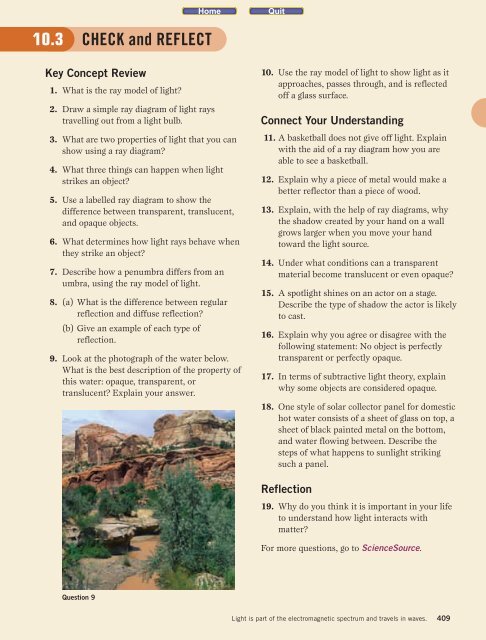is10_sb_unit_d
is10_sb_unit_d
is10_sb_unit_d
You also want an ePaper? Increase the reach of your titles
YUMPU automatically turns print PDFs into web optimized ePapers that Google loves.
10.3 CHECK and REFLECT<br />
Key Concept Review<br />
1. What is the ray model of light?<br />
2. Draw a simple ray diagram of light rays<br />
travelling out from a light bulb.<br />
3. What are two properties of light that you can<br />
show using a ray diagram?<br />
4. What three things can happen when light<br />
strikes an object?<br />
5. Use a labelled ray diagram to show the<br />
difference between transparent, translucent,<br />
and opaque objects.<br />
6. What determines how light rays behave when<br />
they strike an object?<br />
7. Describe how a penumbra differs from an<br />
umbra, using the ray model of light.<br />
8. (a) What is the difference between regular<br />
reflection and diffuse reflection?<br />
(b) Give an example of each type of<br />
reflection.<br />
9. Look at the photograph of the water below.<br />
What is the best description of the property of<br />
this water: opaque, transparent, or<br />
translucent? Explain your answer.<br />
Question 9<br />
10. Use the ray model of light to show light as it<br />
approaches, passes through, and is reflected<br />
off a glass surface.<br />
Connect Your Understanding<br />
11. A basketball does not give off light. Explain<br />
with the aid of a ray diagram how you are<br />
able to see a basketball.<br />
12. Explain why a piece of metal would make a<br />
better reflector than a piece of wood.<br />
13. Explain, with the help of ray diagrams, why<br />
the shadow created by your hand on a wall<br />
grows larger when you move your hand<br />
toward the light source.<br />
14. Under what conditions can a transparent<br />
material become translucent or even opaque?<br />
15. A spotlight shines on an actor on a stage.<br />
Describe the type of shadow the actor is likely<br />
to cast.<br />
16. Explain why you agree or disagree with the<br />
following statement: No object is perfectly<br />
transparent or perfectly opaque.<br />
17. In terms of subtractive light theory, explain<br />
why some objects are considered opaque.<br />
18. One style of solar collector panel for domestic<br />
hot water consists of a sheet of glass on top, a<br />
sheet of black painted metal on the bottom,<br />
and water flowing between. Describe the<br />
steps of what happens to sunlight striking<br />
such a panel.<br />
Reflection<br />
19. Why do you think it is important in your life<br />
to understand how light interacts with<br />
matter?<br />
For more questions, go to ScienceSource.<br />
Light is part of the electromagnetic spectrum and travels in waves.<br />
409


